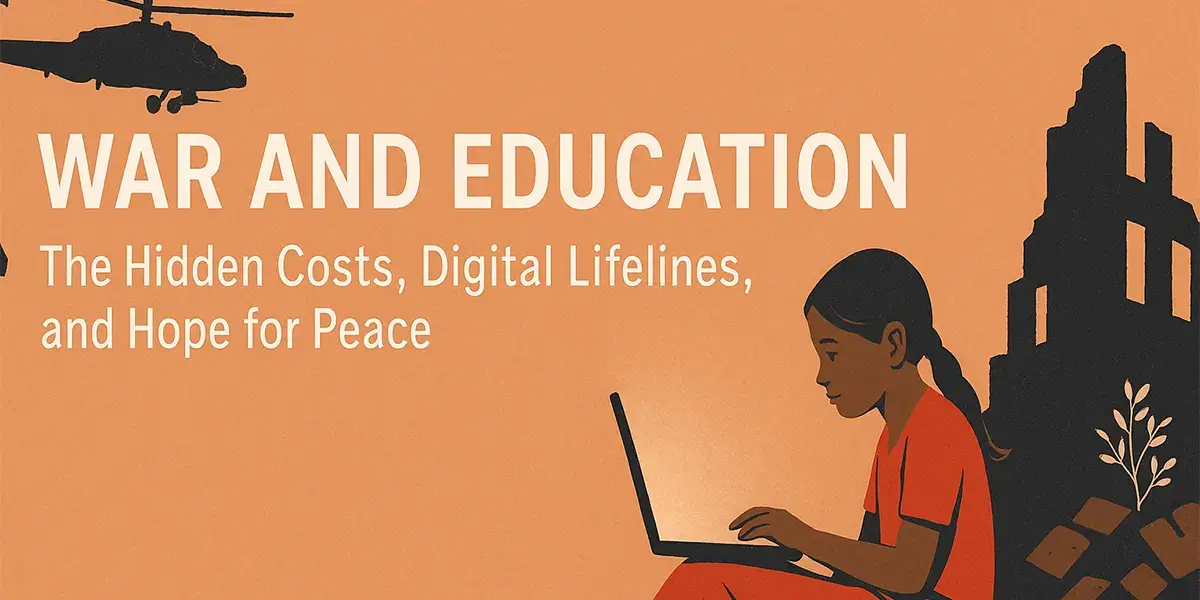They say education builds the future. But what happens when the future is under fire?
In the war-torn corners of the world, classrooms fall silent not because of the summer break but becuase of airstrikes. Chalkboards shattered, backpacks abandoned, and teachers, our everyday heroes, disappear into chaos, their students scattered across borders.
This is not the scene from any movie. Instead, it is the real-world, horrifying scenario we get to see nowadays.
This is not just about destroying buildings. It is about millions of young lives suspended in uncertainty. It’s about missed English lessons, turning into missed opportunities for generations.
In this interesting blog, we are unpacking the true cost of war on education. It’s not just about the broken desks and closed schools, but the emotional turmoil among pupils, the bravery of teachers on the frontlines and the surprising role of digital learning in all this. And most importantly, we’ll ask the big question:
Can education be the very thing that helps prevent future wars?
So, what are you waiting for? Stop scrolling and let’s get into the blog.
The Hidden Costs of Conflict on Education
War impacts learning in ways you can’t even imagine. While media headlines focus on border casualties and politics, they don’t tell how the education gets affected.
Millions of children lose their right to learn.
Don’t believe us? Here’s the stats to prove:
According to UNESCO’s global education monitoring report, attacks on learning increased by 33% globally in 2022, with over 3,000 schools and colleges targeted in armed conflicts. Furthermore, in Ethiopia, Tigray’s two-year conflict left 90% of schools damaged.
Here is another one:
According to UNICEF, more than 222 million school-aged pupils live in crisis-affected areas without any reliable access to schooling.
That’s only half the ratio we get to hear about through the surveys. After the recent scenarios going around the world, the most common question among pupils and teachers is how war threatens the classroom. Well, if that’s what you want to find out, then read below. In this part, we will uncover the cost of war on education that pupils have to pay.
1. Destruction of Infrastructure
Military conflicts not only destroy residential areas or buildings. But also, in fact, even schools are targeted or repurposed during military conflicts.
In places like Syria and Gaza, school buildings have been bombed, turning them into rubble.
Additionally, even if not directly affected, schools often shut down due to their proximity to combat zones. Even security threats affect learning.
2. Displacement and Learning Disruption
Conflict causes mass displacement. Refugee children often spend months or even years without access to formal education.
Moreover, as families flee across borders or into refugee camps, children face long gaps in their learning journey. It also affects literacy, numeracy and future jobs. This displacement continues for years as the aftermath of the war.
3. Brain Drain and Teacher Shortages
When violence erupts, teachers often flee for safety. In countries like China, the UAE, Vietnam, South Korea, and Thailand, teachers are also recruited into military forces.
With fewer teachers and schools operating, students are left to self-teach or drop out entirely.
Well, these hidden costs compound over time.
Why?
The child, out of school for several years, may never catch up on years of studies. Hence, the entire generation may grow up undereducated if at all.
This is not new. It has been happening for a long time.
The Psychological Impact of War on Student Learning and Performance
The trauma of war does not stop at the school gate.
Instead, it continues. For many pupils, the mental burden of surviving a conflict zone makes learning almost impossible.
Honestly, the psychological impact on one’s performance and learning is affected badly. Not only do they become more reserved, but sometimes they might not even want to return to school.
Let’s dive deeper into the psychological impact of war.
A report by Save the Children found that more than 80% of children in Gaza show signs of emotional distress. Similarly, another study shows that in Syria, 1 in 4 children suffer from severe psychological trauma that directly impacts classroom performance.
Trauma and Cognitive Strain
Children who are often exposed to war show the symptoms of post-traumatic stress disorder.
PTSD, anxiety and depression are the worst. They ruin one’s mental health and even impact their ability to concentrate, retain information or even feel safe in a classroom setting.
Many studies show that children going through stress show reduced brain development and poor academic performance.
School as a Place of Fear
Children living in war zones like Syria and Gaza, going to school, can have a terrifying experience. Moreover, the threat of attacks, bombing and even kidnappings creates a constant sense of fear. Children are afraid to go to schools or even step out of their homes or shelters.
Hence, rather than being a haven, schools become another battlefield.
Long-Term Mental Health Challenges
The psychological scars left by war during childhood do not end there. Instead, they follow pupils into adulthood, affecting every phase of life.
Many pupils struggle to regain their identity, confidence, and social interactions, which further limits their educational and professional opportunities.
And addressing these issues is essential. Government, parents and teachers need to work together to ensure a safe and secure future for the pupils who have gone through war.
Here is what they need to do:
- Providing access to the mental health facilities and therapy centres.
- Training teachers and staff about trauma learning so they can help learners overcome that.
- Learning about these challenges and addressing them early on can save the pupils from all the damage.
Learning, which is meant to nurture growth, helps them build a future and become a better person; it becomes stunted under the shadow of war.
Teachers on the Frontlines
In war-torn regions, teachers often become unexpected heroes, working as frontline educators.
Amidst the chaos among pupils, they are the guiding angels who offer stability, guidance and the possibility of normalcy.
That’s not a book talk, nor is it false. In fact, here is a real-life example to prove the point:
In Ukraine, despite bombings and blackouts, over 25% of teachers continued teaching via Telegram and Zoom. Moreover, another research shows that in Afghanistan, female teachers have risked imprisonment to conduct underground classes for girls who were denied formal education.
But, even for them, it is not easy. Their journey is fraught with risks and immense challenges.
From personal risk and sacrifice to a lack of support, they have to overcome hurdles to protect pupils from all this damage.
Here are the problems they have to go through.
Personal Risk and Sacrifice
Teachers in war zones are under threats of violence, limited resources and emotional stress, especially in those countries where education is limited.
Some teachers try teaching in makeshift classrooms in their homes or on streets, refugee camps or underground shelters.
The good thing amidst all this chaos is that many educators who value learning choose to stay behind to support their students.
Educators as Counsellors and Protectors
Apart from being a teacher, educators often take on roles as counsellors, mentors and even guardians. They aid children in processing trauma, provide emotional support and create a sense of normalcy through routine and discipline.
However, they even face emotional turmoil. There are some teachers who have lost their loved ones in war. Hence, this affects their mental health too. So, while they work as mentors, they also need someone who can support them in this tough time.
Lack of Support
Unfortunately, teachers are often underpaid or not paid at all in these settings, making it impossible for the teachers to survive.
With little institutional support, they rely on NGOs, humanitarian aid, or personal dedication to continue teaching. The good thing is that as we progress further, teachers are gaining more support, making it easier for them to help pupils.
Thus, their resilience proves that education should not stop becuase of war, and it doesn’t. Instead, it adapts and survives.
Can Online Learning Be a Lifeline for Students in War Zones?
We are living in a digital world. And as traditional education systems collapse during conflicts, online learning has emerged as a potential solution. While it does have some challenges, digital learning does offer a way for students to continue learning when physical schools are unavailable.
So, in short, online learning can be a lifeline for students in a war zone.
Digital platforms, such as Rumie, Kolibri, and the UN’s Education Cannot Wait initiative, are offering access to both offline and online learning materials.
According to a survey, the Education Cannot Wait fund has reached over 7 million children in crisis zones. It is because of the remote learning kits, solar-powered tablets, and WhatsApp-based lesson plans. In Lebanon, UNICEF supported 40,000 Syrian refugee students with offline e-learning content tailored to their grade level.
Additionally, Refugee children in Jordan are using tablets loaded with educational content for studying when there is no internet connection available.
Moreover, despite the geographical barriers, online education is empowering girls, disabled students and those in remote locations who might otherwise be left behind. Even services like nursing assignment help UK are playing their part. Thus, it allows flexible learning, ensuring everyone has access to it even in a war zone. It can be life-changing for those who are going through the transitional period.
Hence, in short, digital learning, while it can’t be treated as a full replacement, is still becoming a critical tool in maintaining learning during a crisis like war.
Challenges: Limitations of Technology
While we agree that e-learning is powerful during the war, there are significant barriers, too. Many war-affected regions do not have the proper internet, stability, electricity or even digital devices.
Hence, in such areas, students rely on radio-based lessons, SMS learning and community centres with shared devices.
NESCO reports that nearly 70% of school-aged children in Sub-Saharan Africa have no access to the internet or electricity. Thus, this makes digital learning an unequal lifeline.
The Cost of War: How Military Conflict Diverts Resources from Education
So, every dollar spent on bullets is a dollar not spent on books. Moreover, war diverted essential funding away from education and into the defence. Hence, it often causes long-term problems for a country’s development. Here is how it is affecting.
- Shaking the education Budget: In the nations which are affected by the war, national budgets are given to the military. Moreover, tanks and weapons receive priority over school supplies. Also, in Yemen and Afghanistan, education budgets have been cut during wartime.
- International Aid Focus: Even the international donors often redirect their aid toward war relief and military alliances rather than schools. Hence, this leaves the learning programs underfunded and unsustainable.
- Economic Fallout: Underfunded learning causes an unskilled workforce. Hence, this turns into a hurdle to growth.
This gives us a lesson that while war may win territory, it loses the future.
Can Education Prevent Future Wars?
There is no denying that while way destroys learning, education has the power to prevent war. In fact, it is an effective tool for promoting peace and understanding among the pupils.
Moreover, quality education builds critical thinking, empathy and problem-solving skills. Also, pupils learn to question propaganda, reject extremism and seek solutions.
It even teaches them to be tolerant and remain peaceful.
In short, while learning may not stop every war, it makes a peaceful future far more possible.
Post-War Models of Success
In Rwanda, after the 1194 genocide, schools began teaching how to stay united and reconcile.
Moreover, in Colombia, peace learning is now followed in national schools.
So, today, schools need to create a peace curriculum.
What Should a Peace Curriculum Include?
Here are some things that a peace curriculum should include:
- History and cultural studies to understand the roots of conflict.
- Building empathy through the exercises and storytelling.
- Offering training in communication.
- Discussing global citizenship and cooperation.
Thus, such initiatives can help break the cycle of hatred and violence.
Conclusion
In a nutshell, war threatens everything education stands for. Moreover, it tears down classrooms, steals childhood and silences futures. But even in the darkest hours, learning survives. It shifts to tents, travels on USB drives and thrives in teachers and students.
The world must know education is not just a casualty of war but its antidote. By protecting education, we can plant the seeds of stability that will bloom long after the fighting ends.




 UK Cities
UK Cities